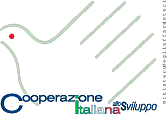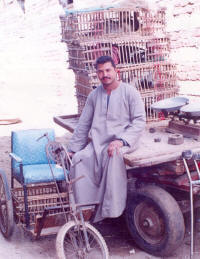to sort out poverty:
a chance from microcredit
International Seminar
9th and 10th of April, 2005 - Cairo
| Social Loan Tracking System |
|
International panel |
|
International Panel
The International panel
Eng Guido Benevento, Italian Cooperation
Now I will open the international panel, and in this panel we have various speakers: Mr Paolo Vitali, from Giordano Dell’Amore Foundation, which is particularly involved in microcredit and microfinance, Mr Antonio Loche, who is the Secretary General of the Italian National Committee for 2005 International Year of Microcredit, Mr Ahmed El Ashmawi of Sanabel, which is a network Organization dealing with Microcredit and Microfinance in the Arab region, and finally we have professor Marcella Corsi, from Fondazione Risorsa Donna, Italy.
Thank you. I will present you an overview of the International Year of Microcredit 2005. This initiative launched by the United Nations comes from the vision of scaling up efforts in building up entrepreneurial skills to meet the demand for microfinance. As we heard from the UN representative in Egypt, Mr Vigilante, the percentage of the people who receive a supply of financial services from formal financial communities is still very low, and the gap with people who do not receive this supply is still great. This could mean that the portion of clients who have access to loans is growing at a 25% rate per year, and to reach our goals we need to increase the amount of access to financial services for these people, and to establish more potential means to use microfinance in a more effective way so to alleviate poverty.
Of course, for the actions to be effective, many actors have to be seriously committed. Between them:
Because of all the activities planned during the whole Year (Blue Book Project, Data Project, Global Microentrepreneurship Awards, Shop Micro, The year of microcredit web site, Microfinance Matters (newsletter), Public Service Announcements & other special Events), what is expected to happen after 2005 is:
Everyone can participate in the activities planned to celebrate the Year: you can set up and support your national committee, you can promote the importance of quality financial services, build commitment in your own organization, volunteer, promote and support capacity building programs such as the Master on Microfinance, which is sponsored by Italian Ministry of Foreign Affairs, because we do trust that training and capacity building is an essential component of microfinance.
I would like to present a survey the title of which is "Microfinance in Arab states"4, the third in a series of publications which document the state of microfinance in the Arab States’ Region and which track the development of this young industry over time.
The survey attempts to map out the major suppliers of microfinance in the region and to highlight the challenges and opportunities available for developing mature initiatives. The first two surveys were undertaken by the Private Sector Development Group of the Middle East and North Africa Region of the World Bank. The Sanabel Microfinance Network was the key force behind the third survey, having decided to institutionalize the regular update of MFI data as part of its core regional initiatives.
Sanabel, the Microfinance Network of the Arab Countries, is a membership-driven regional network for microfinance institutions in the Arab world. Today the network has 27 institutional members. These 27 MFIs together are estimated to serve 70% of the number of active borrowers in the region. Sanabel was founded in September 2002 by 17 representatives from seven countries (Egypt, Jordan, Lebanon, Morocco, Occupied Palestinian Territories, Tunisia, and Yemen). The founding members—14 institutions and three individuals— formulated the by-laws and membership criteria, the vision, and the mission and the objectives of the organization, and elected an Executive Committee for the network. The start-up of Sanabel and its initial operations have been supported by the Rockdale Foundation.
In the spring of 2003, Sanabel sent out a comprehensive 19-page questionnaire through its local country representatives to all the known MFIs in the Arab States asking for data on loan portfolios and key performance indicators by the end of year 2002.
The questionnaire also asked for information on governance, legal issues, management issues, and products and services. The initial feedback was disappointing because only a small minority of institutions responded to the questionnaire. This was most likely caused by the fact that the questionnaire was too long and very technical in nature. Furthermore, Sanabel was still quite young and as such not fully established as a representative network in the region. At the same time, the use of local MFI focus points operating in the same sector may have made MFIs reluctant to reply because of competitive issues.
Finally, the fact that in some countries, such as Lebanon, many MFIs did not meet the Sanabel eligibility criteria for becoming a member, heavily reduced MFI receptivity of the initiative. However, afterwards time and effort were dedicated to respondents and therefore a relatively complete and reliable 2002 year dataset was established for 51 MFIs. A mini-questionnaire covering year 2003 data (where available) was collected during the Conference on Microfinance in the Arab World in December 2003 and this helped fill up many gaps and provide further basis for analysis.
Egypt has also increased women’s loans: while at the end of 1999 only 25% of the clients were women, this proportion had increased to 35% by the end of 2002 and 46% by the end of year 2003. We will see below that this can be attributed to the introduction of women group lending from the USAID-supported Foundations, which together with the Banque du Caire and the National Bank for Development dominate the market.
The remarkable growth in Egypt can be attributed to two key factors: loan product diversification with the introduction of group lending (for women especially); and the revitalization of downscaling programs through banks, notably through the Banque du Caire; both initiatives were sponsored by the major donor in the sector, USAID. The microfinance scheme in Egypt as well as in many countries in the region has been characterized by a general lack of product diversification. This has occurred up to very recently that is till when USAID began putting a renewed emphasis on its poverty lending projects, by defining the quantity of each money loan at around less than $300.
In an effort to reach more poor people and improve its gender balance, EQI— Environmental Quality International, USAID’s Technical Assistance Provider in Egypt—designed and implemented a new group-lending product for women in all seven of USAID’s partner Foundations. Before this, the Foundations had focused only on individual loans from which women were not excluded, even though the majority of borrowers were men.
Just very briefly I would like to explain who we are: we are a Foundation that mainly deals with gender and microcredit and is a member of the Italian National Committee for 2005 International Year of Microcredit.
Today I am going to introduce our project, Women and Microfinance, a new path for development in Mediterranean countries, a research that will be presented in Italy in September, which is absolutely coherent with what we are discussing today. The information about the program itself can be required to our institution and I will be glad to be contacted later to give more details on our work.
This kind of activity is focused on the growing empirical evidence about the return on loans of the female participation. There are not only a lot of good practices but also a lot of literature on this topic and when we look at it what comes out is that the impact of microfinance interventions on women might have some controversial but relevant results: that is, some studies have confirmed that the economic and social empowerment that microfinance programs have on female participants might be very effective as far as I could see from the work which has been done so far within PAP. Some remarkable results have come out from the experience carried out in Egypt. And I am really glad to say that, with this opportunity we have actually established contacts and collaboration with the staff of PAP and the Italian Cooperation in Egypt, and we intend to go on in this direction.
Other studies, on the other hand, also affirm that the relation between women’s access to loans and women’s empowerment is not that strong: this is why we are collecting information, through a questionnaire, on how microcredit programs affected women’s lives in the Mediterranean area. For this reason we have contacted Sanabel, a network of MFIs that will support us in broadening our own network, and tried to put into contact MFIs from Middle East with those which operate in Kosovo, Montenegro, Bosnia and Croatia.
Finally, last but not least, we are presently concentrating on the microcredit experiences in our countries, in Italy, first of all, because we are, as I said, an Italian microcredit institution.
_____ 4. Brandsma, Burjorjee , ibidem
|

 Mr Paolo
Mr Paolo



 Prof. Marcella
Prof. Marcella 